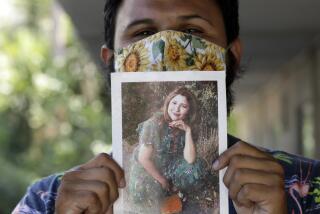Victims compensation plan is unprecedented
WASHINGTON — The U.S. government has committed itself to paying in full the nearly 6,000 families who lost a loved one in the Sept. 11 attacks, an unprecedented move, legal experts say.
Under a measure attached to the airline bailout bill, the government will compensate the families of those who died, as well as the more than 7,000 people who were injured, in the same way that airlines pay damages to those killed or hurt in a plane crash.
They are entitled to payment for the family’s “economic losses,” including lost wages for the years ahead. They are also due compensation for their emotional pain and suffering, under the terms of the law.
And unlike lawsuits, which take years to resolve, the victims’ compensation payments will be determined within four months after claims are filed by a single “special master” who is to be appointed by Attorney General John Ashcroft.
“This has never been done before. It’s unique, but then we’ve have never experienced something quite like this before,” said Carlton Carl, a spokesman for the Association of Trial Lawyers for America.
Undoubtedly, it will be a costly step as well.
In the past, the federal government has paid billions of dollars in disaster aid after hurricanes, earthquakes and floods. The Federal Emergency Management Agency said it spent a record $7 billion after the 1994 Northridge earthquake.
The government has also set up special-purpose funds to compensate the Vietnam-era soldiers who were exposed to Agent Orange, and individuals, primarily children, who become ill as a result of taking an approved vaccine.
Until now, however, the government has not assumed the full liability cost for all the individual victims of a mass disaster.
“This is uncharted territory,” said DePaul University Law School Professor Stephan Landsman. “When we have faced a massive problem of personal injuries before, like with tobacco or asbestos, we’ve tended to duck and say, “Let the courts figure it out.’ Now, the government is stepping forward and saying, “We will compensate on a dollar-for-dollar basis.’ It’s the fair and decent thing, and we may be taking a big step forward in the law.”
In recent years, airline crashes have resulted in legal payouts of more than $2 million per person, industry experts say.
No one knows how much the new “September 11th Victim Compensation Fund” will cost the government. And few are even willing to venture a guess.
“I’ve heard figures like $15 billion, but that’s pulled out of the sky,” said Robert Clifford, a Chicago attorney who chairs a new American Bar Association task force on terrorism and the law. “I’ll wager the people writing this at 2 in the morning didn’t call the Congressional Budget Office for a cost estimate,” he added.
He referred to the extraordinary circumstances that led to the bill’s passage. In the late-evening hours of Sept. 20, after President Bush addressed a joint session of Congress, the leaders of both houses met to hammer out the emergency airline bailout.
Industry lobbyists were saying several carriers would go out of business unless Congress came to the rescue immediately. Democrats, led by Sen. Patrick Leahy, D-Vt., argued that the government should not limit its response to big business.
“I said we’ve got to figure out how to help the victims. And we need to do it with speed,” Leahy said. “Thousands of kids went to school that day and came home to learn they were orphans. Is this program perfect? No, but it’s the best we could do in the short term.”
Leahy and the Democrats insisted that the fund should have no dollar limit. It’s impossible to put a value on human life, they said.
Republicans, wary of the ballooning cost, demanded that Ashcroft’s office choose the special master, the person who will decide on the payouts. They also insisted that the master’s word would be final. No legal appeals would be permitted.
With that as guidance, staff lawyers wrote the provisions of the compensation fund during the middle of the night, and the Air Transportation Stabilization Act quickly passed the House and Senate on Friday, Sept. 21, and was signed into law by President Bush.
Since then, lawyers and government officials have been figuring how the program will work. The Justice Department was given 90 days to devise regulations and come up with a special master.
“We’re dealing with a gigantic issue. We can’t guess how many people will apply,” said Charles Miller, a department spokesman. “All I can say now it’s a high priority for the attorney general.”
The law itself sets some limits. Only one claim per victim is permitted. Beneficiaries and families whose members disagree on how to divide the compensation will have to work that out on their own, officials say.
And claimants must choose between the federal compensation fund and going to court. They cannot do both.
Beyond that, federal claims will be reduced by the amount victims receive from “all collateral sources,” including “life insurance, pension funds, death benefits” and other government aid.
A controversy already has arisen over whether this includes money from the many charitable funds set up to help victims and their families. Staff lawyers who worked on the bill say no one thought of clarifying that point.
“This is sort of dicey. It needs to be straightened out soon,” Landsman said. Charities are not sure whether they should give money directly to families now if it will be subtracted from their compensation in a few months, he said.
Some also foresee controversy ahead if some families seek tens of millions of dollars in compensation from the government.
In litigation over airline crashes, lawyers do put a value on human life. They calculate a family’s loss based on the projected lifetime income of the deceased.
The result is that payouts vary greatly.
“There is no average. It depends on the facts regarding that person. We’ve had recoveries as high as $25 million and as low as $600,000,” said Lee Kriendler, a prominent New York aviation lawyer. He represented families after the midair explosions of Pam Am flight 103 over Lockerbie, Scotland, in December, 1988, and TWA flight 800 off Long Island in July, 1996.
The new federal compensation fund follows the rule of airline litigation in focusing on the economic losses suffered by each family.
“In this case, you could have a Cantor Fitzgerald (stock) broker and a coffee broker lost in the (World) Trade Center,” David Golomb, a New York trial lawyer, said to illustrate the potential for greatly different compensation awards.
While the family of the high-earning professional could ask the government for tens of millions of dollars in compensation, low-wage workers might be limited to a small fraction of that amount, he said.
But Golomb and other trial lawyers say many families of top earners may shun the government program. They may be owed large amounts from life insurance or pension funds, and therefore, would have little to gain from the federal program.
More to Read
Sign up for Essential California
The most important California stories and recommendations in your inbox every morning.
You may occasionally receive promotional content from the Los Angeles Times.











